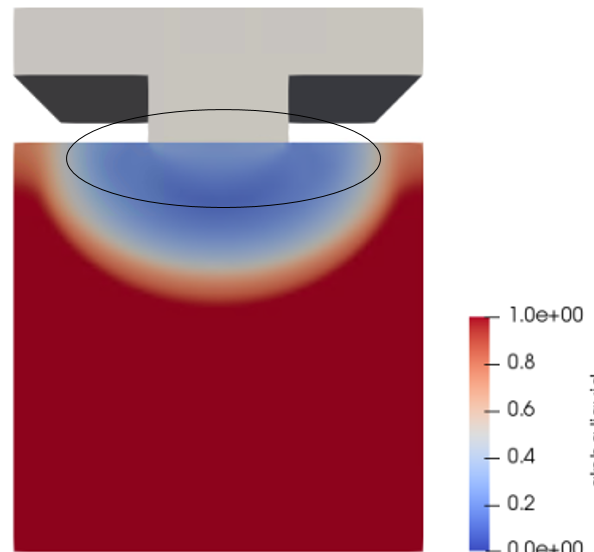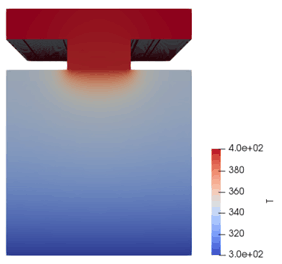气液两相 没有纯气体
-


上面是加热壁面,下面全都是多孔区域(孔隙率0.73),然后我产生的液相分布是这样的~ 几乎没有纯气体区域~甚至在固液界面处的液相含量反而高~我已经调过不同的毛细力模型,发现不是毛细力的影响~
现在还可以做的是增大相变系数~但是我相变系数一增大,就会在开始相变的时候发散~有没有老师可以分析一下 可能是哪里导致的问题~
solvers { "alpha.liquid.*" { cAlpha 1; nAlphaCorr 2; nAlphaSubCycles 2; MULESCorr yes; nLimiterIter 5; solver smoothSolver; smoother symGaussSeidel; tolerance 1e-7; relTol 0; } rho { solver diagonal; tolerance 1e-7; relTol 0.1; } rhoFinal { $rho; tolerance 1e-7; relTol 0; } mDotSmearFinal { solver PCG; tolerance 1e-7; preconditioner DIC; relTol 0.00; smoother DIC; } "(U|T)" { solver smoothSolver; smoother symGaussSeidel; tolerance 1e-7; relTol 0.; minIter 15; maxIter 50; }; "(U|T)Final" { $U; tolerance 1e-7; relTol 0; maxIter 50; } p { tolerance 1e-8; solver PCG; preconditioner DIC; relTol 0.001; smoother DIC; } pFinal { $p; tolerance 1e-07; relTol 0; } "pcorr.*" { $p_rgh; tolerance 1e-9; relTol 0; }; } PIMPLE { momentumPredictor yes; nCorrectors 5; nNonOrthogonalCorrectors 0; pRefCell 0; pRefValue 1e5; } relaxationFactors { alpha.liquid 0.2; U 0.5; p 0.5; }ddtSchemes { default Euler; } gradSchemes { default Gauss linear; } divSchemes { div(phi,alpha) Gauss vanLeer01; div(phirb,alpha) Gauss vanLeer01; //div(phirb,alpha) Gauss interfaceCompression; //div(rhoPhi,U) Gauss vanLeerV; //div(rhoPhi,U) Gauss limitedLinearV 1; div(rhoPhi,U) Gauss linearUpwind; div(rhoPhiByEps,U) Gauss linearUpwind; div((mu*dev2(grad(U).T()))) Gauss linear; div(((rho*nuEff)*dev2(T(grad(U))))) Gauss linear; div(((rho*nu)*dev2(T(grad(U))))) Gauss linear; div(rhoCpPhi,T) Gauss vanLeer; div((interpolate(cp)*rhoPhi),T) Gauss vanLeer; } laplacianSchemes { default Gauss linear corrected; } interpolationSchemes { default linear; } snGradSchemes { default corrected; }
